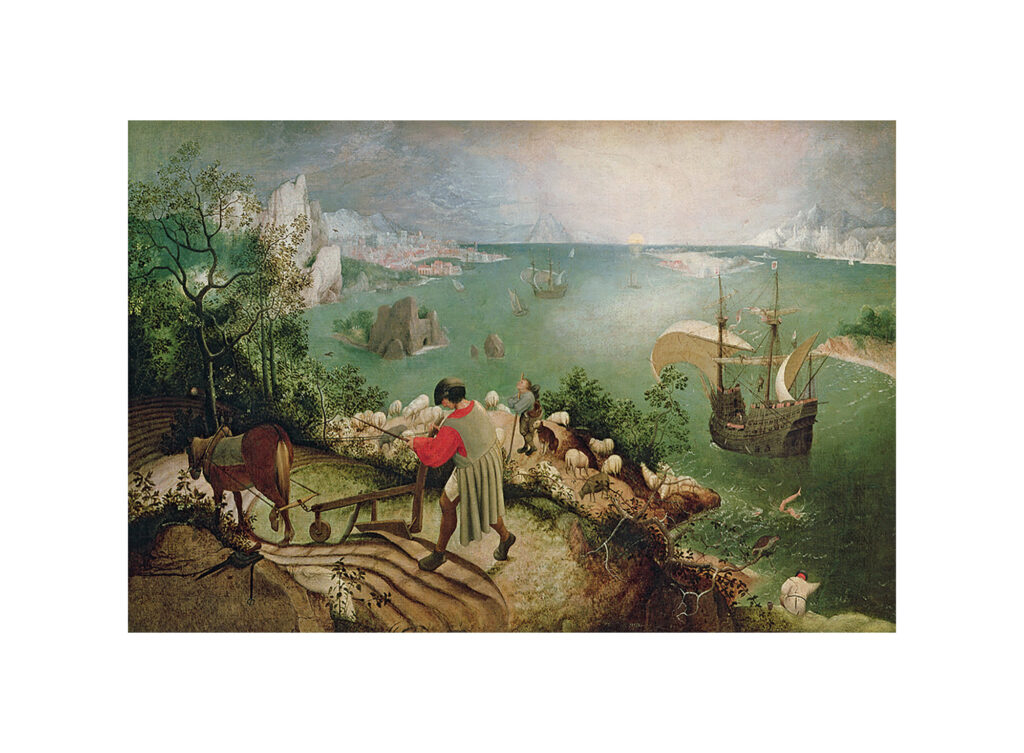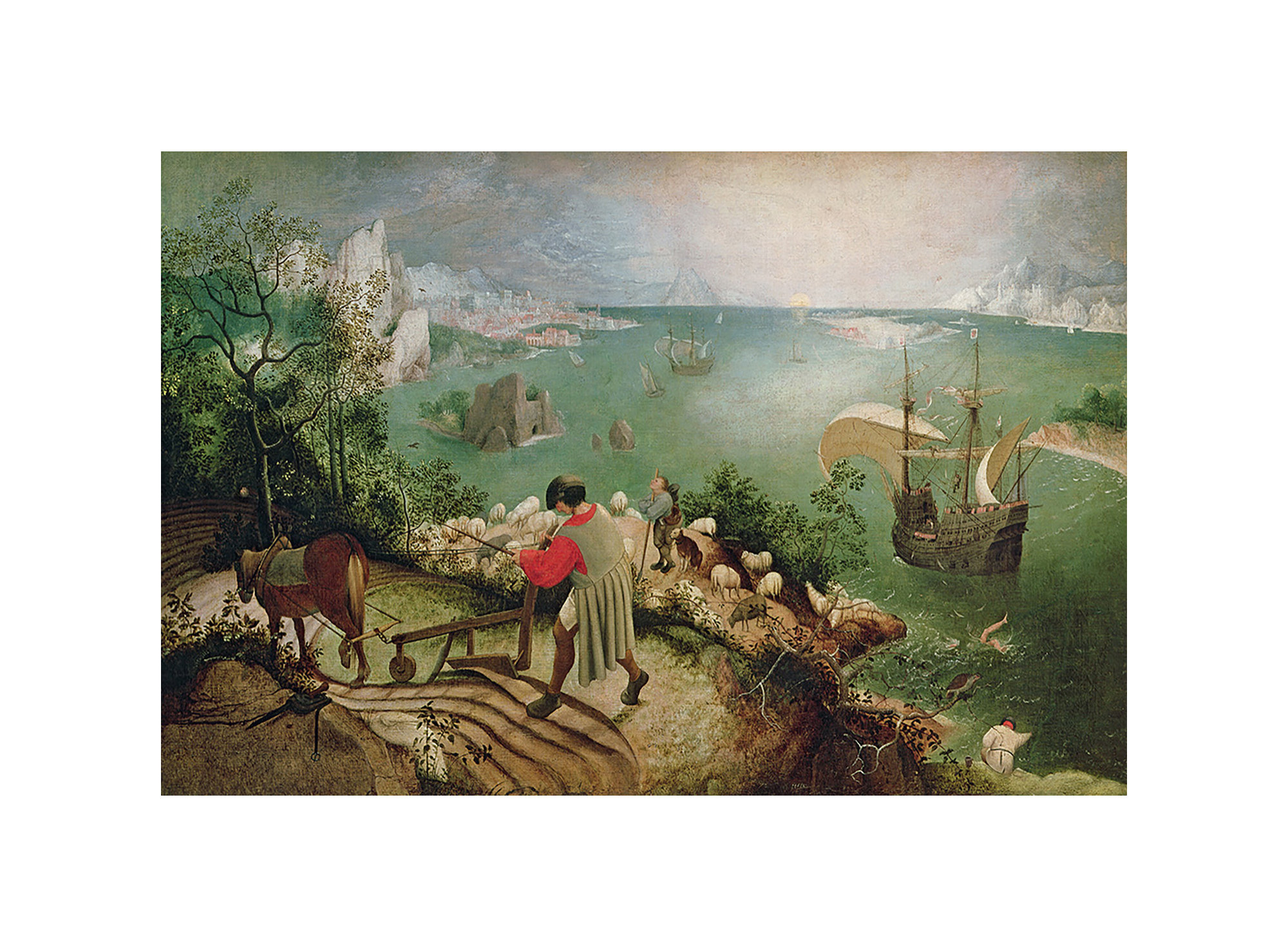
Decoding Bruegel’s Masterpiece: A Deep Dive into ‘Landscape with the Fall of Icarus’ Painting
Pieter Bruegel the Elder’s ‘Landscape with the Fall of Icarus‘ painting is a deceptively simple scene. At first glance, it appears to be a serene depiction of rural life. Farmers plow their fields, a shepherd tends his flock, and ships sail calmly on the sea. However, a closer look reveals a tiny detail in the lower right corner: two small legs flailing in the water. This is Icarus, whose legendary fall from the sky is the subject of this complex and profound artwork. This article delves into the intricacies of the Landscape with the Fall of Icarus, exploring its historical context, artistic techniques, and enduring interpretations.
The Myth of Icarus: A Brief Recap
Before analyzing the painting, it’s crucial to understand the myth of Icarus. In Greek mythology, Daedalus, a master craftsman, was imprisoned on the island of Crete with his son, Icarus. To escape, Daedalus fashioned wings from feathers and wax. He warned Icarus not to fly too close to the sun, as the heat would melt the wax. However, Icarus, intoxicated by the thrill of flight, ignored his father’s warning and soared too high. The wax melted, his wings disintegrated, and he plunged into the sea.
Bruegel’s Depiction: A Subversion of Expectations
Bruegel’s ‘Landscape with the Fall of Icarus‘ is remarkable for its understated portrayal of a dramatic event. Unlike many other artists who focused on the moment of Icarus’s fall, Bruegel relegates it to a minor detail. The painting emphasizes the indifference of the natural world to human tragedy. The farmers continue their work, the shepherd minds his sheep, and the ships sail on, seemingly oblivious to Icarus’s demise. This creates a powerful contrast between the epic scale of the myth and the mundane reality of everyday life.
Historical Context: The Renaissance and Humanism
The painting was created during the Renaissance, a period characterized by a renewed interest in classical art and literature. However, the Renaissance also saw the rise of humanism, a philosophical movement that emphasized human potential and achievement. Bruegel’s painting reflects this tension between classical ideals and humanist values. While the myth of Icarus serves as a cautionary tale about hubris, Bruegel’s depiction also suggests a critique of the Renaissance’s focus on individual ambition. The Landscape with the Fall of Icarus subtly questions the pursuit of glory at the expense of prudence.
Artistic Techniques: Composition and Perspective
Bruegel’s mastery of composition and perspective is evident in the ‘Landscape with the Fall of Icarus‘. He uses a high vantage point to create a panoramic view of the landscape. This allows him to incorporate a wide range of details, from the distant mountains to the individual blades of grass. The painting is divided into three distinct planes: the foreground, the middle ground, and the background. The foreground is dominated by the farmer plowing his field, while the middle ground features the shepherd and the ships. Icarus’s fall occurs in the background, almost as an afterthought. This deliberate arrangement emphasizes the insignificance of Icarus’s tragedy in the grand scheme of things. The perspective draws the eye across the canvas, making the viewer an active participant in observing the scene, and ultimately discovering the tiny legs of Icarus.
Symbolism and Interpretation: Multiple Layers of Meaning
The ‘Landscape with the Fall of Icarus‘ is rich in symbolism and open to multiple interpretations. Some scholars argue that the painting is a commentary on the folly of ambition. Icarus’s desire to fly too close to the sun represents the dangers of overreaching and ignoring wise counsel. Others suggest that the painting is a critique of the indifference of society to individual suffering. The fact that no one seems to notice or care about Icarus’s fall highlights the callousness of human nature. Still others see the painting as a celebration of the resilience of everyday life. Despite the tragedy of Icarus, life goes on. The farmers continue to work, the shepherd tends his flock, and the ships sail on. This suggests that even in the face of death and despair, there is still hope and beauty in the world.
The presence of the partridge, a bird often associated with cunning and deception, has also been analyzed. Some interpret the partridge as a symbol of Daedalus, Icarus’s father, who was known for his ingenuity and craftiness. The partridge’s presence could suggest that Daedalus, despite his role in Icarus’s demise, is still watching over the scene, perhaps lamenting his son’s fate. The plowman, the shepherd, and the fisherman all represent different aspects of human endeavor, and their obliviousness to Icarus’s plight underscores the theme of human indifference to suffering.
The Authenticity Debate: Is it Really Bruegel?
The authenticity of the ‘Landscape with the Fall of Icarus‘ has been debated among art historians for many years. While the painting is widely attributed to Pieter Bruegel the Elder, some scholars believe that it may be a copy or a workshop production. The painting’s relatively poor condition and the lack of preparatory drawings have fueled this debate. However, recent technical analysis has revealed evidence that supports Bruegel’s authorship. Pigment analysis and X-ray imaging have shown that the painting is consistent with Bruegel’s other works. While the debate may continue, the ‘Landscape with the Fall of Icarus‘ remains a significant and influential work of art, regardless of its precise provenance.
The Painting’s Influence on Literature and Art
The ‘Landscape with the Fall of Icarus‘ has had a profound influence on literature and art. W.H. Auden’s poem “Musée des Beaux Arts” is a direct response to the painting, reflecting on the human capacity for indifference to suffering. Auden writes, “About suffering they were never wrong, / The Old Masters: how well they understood / Its human position; how it takes place / While someone else is eating or opening a window or just walking dully along.” Other artists and writers have also drawn inspiration from Bruegel’s masterpiece, using it as a starting point for their own explorations of human nature and the relationship between art and life. The painting’s enduring appeal lies in its ability to provoke thought and challenge our assumptions about the world.
Where to See the ‘Landscape with the Fall of Icarus’
The ‘Landscape with the Fall of Icarus‘ is currently housed in the Royal Museums of Fine Arts of Belgium in Brussels. Visiting the museum and seeing the painting in person is an unforgettable experience. The painting’s subtle details and nuanced composition are best appreciated firsthand. The museum also offers a wealth of information about Bruegel’s life and work, providing valuable context for understanding the painting’s significance. Seeing the scale of the painting and the detail within it brings a new appreciation for Bruegel’s skill. Viewing the original allows the viewer to fully appreciate the subtlety of the colors and the nuances of the brushstrokes, aspects that are often lost in reproductions.
The Enduring Legacy of Bruegel’s Masterpiece
Pieter Bruegel the Elder’s ‘Landscape with the Fall of Icarus‘ remains a powerful and relevant work of art centuries after its creation. Its themes of ambition, indifference, and resilience continue to resonate with audiences today. The painting’s subtle details and complex symbolism invite viewers to engage with it on multiple levels, making it a truly timeless masterpiece. The Landscape with the Fall of Icarus is a testament to Bruegel’s genius and a reminder of the enduring power of art to illuminate the human condition. The painting’s ability to provoke thought and inspire reflection ensures its place in the canon of Western art for generations to come. The Landscape with the Fall of Icarus continues to be studied and admired, its message as relevant today as it was when it was first painted. The painting’s subtle commentary on human nature and the world around us is what makes the Landscape with the Fall of Icarus such a compelling work of art.
The Landscape with the Fall of Icarus serves as a reminder of the importance of humility and the dangers of unchecked ambition. The Landscape with the Fall of Icarus also speaks to the human condition, our capacity for both great achievement and tragic failure. The Landscape with the Fall of Icarus, therefore, is more than just a painting; it is a reflection of ourselves.
[See also: Bruegel’s Peasant Wedding: A Celebration of Life]
[See also: The Triumph of Death: A Grim Vision of the Apocalypse]
[See also: The Hunters in the Snow: A Winter Landscape Masterpiece]

